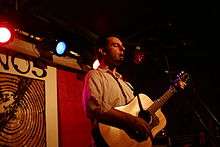Bobby Sichran

Bobby Sichran (real name Robert Lichtman, died February 2015)[1] was a Jewish-American alternative hip hop musician.[2] His music was often described as combining hip hop with several other musical genres, such as blues rock[3] and folk music.[4] His fusion of these genres has led many critics to compare him to Beck,[3][5] and, in some cases, even say that he originated the fusion of folk and hip hop before Beck made it famous.[4][6] Others have compared him to Bob Dylan, but Sichran criticized such comparisons, saying that he would "never want [his] music to exist on comparisons to someone else."[7]
Early career
A native of Long Island, Sichran dropped out of Columbia University in the early 1990s, looking for a musical career. While doing so, he worked as a furniture mover for some time before getting his big break after knocking on the door of Public Enemy's studio.[4] After Hank Shocklee let him in at his request, Sichran ended up working as an apprentice engineer in their studio, and later played guitar on and produced Das EFX's debut album, Dead Serious.[5]
Solo career
On May 3, 1994, Sichran released his debut album, From a Sympathetical Hurricane, on Columbia Records. It was preceded by the single "Stray Dog."[7] Record executive David Kahne said with regard to the album that "Every time I listen to this record, I hear more stuff."[7] Nevertheless, the album was not promoted by Columbia,[6] and ended up being a commercial flop.[5] Sichran went on to release a 7" single in 1997 entitled "All the Psychotics in My Building" on Messenger Records, the B-side of which, "There's So Much You Could Love," appeared on "Wouldn't it Be Beautiful?", a 1999 Messenger compilation album.[4] He released a 12" in 1998 entitled "Smoke of the Ghetto", which was described as being a preview of an upcoming album of the same name.[8] However, this album was never released, and he did not release another studio album until 2007's "Peddler in Babylon".[9] According to the Columbia Spectator, Sichran conceived this album as "a concept album about the modern American's crisis of faith".[10] A review of Peddler in Babylon in the Jerusalem Post described it as "a heady meditation on spiritual exile that doesn't badger the listener with yiddishkeit, but clearly bears a Jewish soul."[11]
Discography
Studio albums
- From a Sympathetical Hurricane (1994) - Columbia Records
- Peddler in Babylon (2007) - Bombi Beat Media
Singles
- Soundboy Limbo (1994) - Kings Crown (as Singing Teeth with Vincent Hans)
- All the Psychotics in My Building (1996) -Messenger Records (7")
- Smoke of the Ghetto (1998) (12")
References
- ↑ Pesca, Mike (13 February 2015). "The Read Meets the Spiel". Slate. Retrieved 11 April 2015.
- ↑ Nelson, Havelock (26 November 1994). "Hip-Hop Jumps Cultural Lines". Billboard. 106 (48): 34, 44.
- 1 2 Levine, Robert. "Bobby Sichran". Trouser Press. Retrieved 20 May 2014.
- 1 2 3 4 Swihart, Stanton. "Bobby Sichran Biography". Allmusic. Retrieved 20 May 2014.
- 1 2 3 Aaron, Charles (November 1996). "Singles". Spin. Retrieved 20 May 2014.
- 1 2 Boss, Shira (February 2000). "Brandon Kessler '96: Entrepreneur Works the Business Side of the Music Biz". Columbia College Today. Retrieved 21 May 2014.
While working at Sony he met Bobby Sichran, a former Columbia student and a Long Island singer who has been credited with starting the folk/hip hop fusion. "He'd had a Columbia Records release that got a lot of critical acclaim but was ignored by the record label. It wasn't promoted," Kessler says. They decided to release a single together, and so, with money he had saved from his jobs, Kessler launched Messenger Records during his senior year.
- 1 2 3 Flick, Larry (26 March 1994). "Sichran Spins out 'Hurricane' for Columbia". Billboard. Retrieved 20 May 2014.
- ↑ Flick, Larry (16 May 1998). "Singles". Billboard. Retrieved 20 May 2014.
- ↑ Peddler In Babylon, Drowned in Sound
- ↑ De Vogel, Sasha (27 February 2007). "Blues of Babylon". Columbia Spectator. Retrieved 20 June 2014.
- ↑ Jacobson, Ben (19 June 2007). "Jewish Discs". The Jerusalem Post. Retrieved 10 April 2016.